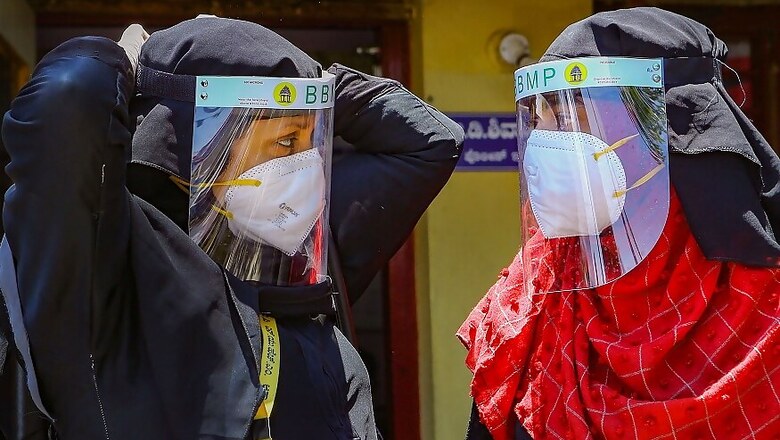
views
Coronavirus Disease 2019 (Covid-19), a viral respiratory illness caused by the severe acute respiratory syndrome coronavirus 2 (SARS-CoV-2), may predispose patients to thrombotic disease, both in the venous and arterial circulations.
Blood clotting is a natural mechanism in response to an injury. However, when a blood clot forms within a blood vessel (known as a thrombus), it can block the vessel and restrict blood flow. Many of the times, this can lead to severe medical emergencies like strokes or heart attacks. If a thrombus breaks and travels to another part of the body, it is called an embolus. If an embolus reaches the blood vessels of lung, brain, heart, kidney or limbs, the ensuing embolism can become life-threatening.
Viral infections can activate the blood-clotting pathway in many ways. It is believed that this process evolved as a mechanism to limit the spread of a viral infection. To assess blood clotting in a person, healthcare professionals often measure the amount of a protein complex called D-dimer in the blood. D-dimer is produced in the blood after an enzyme called plasmin degrades the blood clot in a process called fibrinolysis. High D-dimer levels in the blood are an indication of thrombosis and embolism.
Now it is evident that Covid-19 is more than a lung infection and also affects blood vessels of lungs and other organs by development of thromboembolism. Covid-19 may lead to pulmonary artery embolism (which is a blood clot that has travelled to the lung vessels) by activating the coagulation system or causing a cytokine storm, in which high levels of proinflammatory cytokines start to attack the body's own tissues rather than just the virus.
A study published from France reported that 23 out of 100 patients in the hospital with severe Covid-19 had signs of pulmonary embolism. A decrease in platelet count and increased D-dimer levels are associated consistently with coronavirus disease and carry higher risk of requiring ICU admissions, mechanical ventilation, or death. Severity of this disease is linked to abnormalities in blood coagulation parameters. Another research in France echoed the same findings and reported 30% of 106 patients in the hospital with severe Covid-19 showed signs of blood clots in their lungs.
Covid-19 has a high thrombosis risk with emergency life-threatening events that require adequate treatment with anticoagulants on the basis of laboratory and radiology findings. These clots could enter the lungs, or the heart or brain, resulting in pulmonary embolism, heart infarction, or stroke. Most of the patients who had blood clots had them in their lungs. To a lesser extent, clots were found in the brain or heart - but that number is still seven to ten times higher than normal. A worrying finding is that the cerebral infarctions also affected people who had no risk factors prior to the coronavirus, such as high blood pressure, high cholesterol or a tobacco addiction.
Most published data on coagulation disorders related to Covid-19 have been derived from studies on Chinese patients, but race and ethnicity have major effects on thrombotic risk. Epidemiological studies have found that the incidence of thrombotic events is three to fourfold lower in Chinese patients than it is in Caucasians, and is significantly higher in African-Americans than it is in Caucasians.
In the prospective cohort study, published in the Annals of Internal Medicine, researchers discovered that the direct cause of death in four patients was massive pulmonary embolism (blood clot that lodged in a lung artery, causing a blockage) from deep-vein blood clots in the legs. In an observational study from the Netherlands with 184 Covid-19 patients with proven pneumonia admitted to the ICU, 31 patients developed thromboembolism.
Regardless of the cause, doctors should always suspect pulmonary embolism in Covid-19 patients who are deteriorating. Patients with Covid-19 who have increased D-dimer levels, a sign of coagulopathy, may benefit from anticoagulant treatment. Patients who are admitted to the intensive care unit (ICU) are at highest thrombotic risk. Knowledge on the incidence of thrombotic complications in Covid-19 patients is, therefore, important for determining the intensity of thromboprophylaxis.
Each day the pandemic brings shocking facts to our notice, helping us learn more about the disease. On one hand, this is telling us how much worse the disease can be, but on the other, it gives us ideas to combat it. This pandemic has certainly helped us work in close collaborations and we are fighting this crisis by learning from the best of the practices in different parts of the globe.
(Abhishek Shankar is an Assistant Professor in the Department of Radiation Oncology at Lady Hardinge Medical College & SSK Hospital, Delhi. Rakesh Yadav is Professor in the Department of Cardiology at All India Institute of Medical Sciences, Delhi. Views expressed are personal.)




















Comments
0 comment